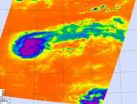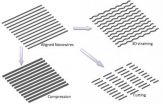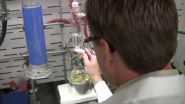(Press-News.org) Johns Hopkins researchers have created a synthetic protein that, when activated by ultraviolet light, can guide doctors to places within the body where cancer, arthritis and other serious medical disorders can be detected.
The technique could lead to a new type of diagnostic imaging technology and may someday serve as a way to move medications to parts of the body where signs of disease have been found. In a study published in the Aug. 27-31 Online Early Edition of Proceedings of the National Academy of Sciences, the researchers reported success in using the synthetic protein in mouse models to locate prostate and pancreatic cancers, as well as to detect abnormal bone growth activity associated with Marfan syndrome.
The synthetic protein developed by the Johns Hopkins team does not zero in directly on the diseased cells. Instead, it binds to nearby collagen that has been degraded by various health disorders. Collagen, the body's most abundant protein, provides structure and creates a sturdy framework upon which cells build nerves, bone and skin. Some buildup and degradation of collagen is normal, but disease cells such as cancer can send out enzymes that break down collagen at an accelerated pace. It is this excessive damage, caused by disease, that the new synthetic protein can detect, the researchers said.
"These disease cells are like burglars who break into a house and do lots of damage but who are not there when the police arrive," said S. Michael Yu, a faculty member in the Whiting School of Engineering's Department of Materials Science and Engineering. "Instead of looking for the burglars, our synthetic protein is reacting to evidence left at the scene of the crime," said Yu, who was principal investigator in the study.
A key collaborator was Martin Pomper, a School of Medicine professor of radiology and co-principal investigator of the Johns Hopkins Center of Cancer Nanotechnology Excellence. Pomper and Yu met as fellow affiliates of the Johns Hopkins Institute for NanoBioTechnology. "A major unmet medical need is for a better non-invasive characterization of disrupted collagen, which occurs in a wide variety of disorders," Pomper said. "Michael has found what could be a very elegant and practical solution, which we are converting into a suite of imaging and potential agents for diagnosis and treatment."
The synthetic proteins used in the study are called collagen mimetic peptides or CMPs. These tiny bits of protein are attracted to and physically bind to degraded strands of collagen, particularly those damaged by disease. Fluorescent tags are placed on each CMP so that it will show up when doctors scan tissue with fluorescent imaging equipment. The glowing areas indicate the location of damaged collagen that is likely to be associated with disease.
In developing the technique, the researchers faced a challenge because CMPs tend to bind with one another and form their own structures, similar to DNA, in a way that would cause them to ignore the disease-linked collagen targeted by the researchers.
To remedy this, the study's lead author, Yang Li, synthesized CMPs that possess a chemical "cage" to keep the proteins from binding with one another. Just prior to entering the bloodstream to search for damaged collagen, a powerful ultraviolet light is used to "unlock" the cage and allow the CMPs to initiate their disease-tracking mission. Li is a doctoral student from the Department of Chemistry in the Krieger School of Arts and Sciences at Johns Hopkins. Yu, who holds a joint appointment in that department, is his doctoral adviser.
Yu's team tested Li's fluorescently tagged and caged peptides by injecting them into lab mice that possessed both prostate and pancreatic human cancer cells. Through a series of fluorescent images taken over four days, researchers tracked single strands of the synthetic protein spreading throughout the tumor sites via blood vessels and binding to collagen that had been damaged by cancer.
Similar in vivo tests showed that the CMP can target bones and cartilage that contain large amounts of degraded collagen. Therefore, the new protein could be used for diagnosis and treatment related to bone and cartilage damage.
Although the process is not well understood, the breakdown and rebuilding of collagen is thought to play a role in the excessive bone growth found in patients with Marfan syndrome. Yu's team tested their CMPs on a mouse model for this disease and saw increased CMP binding in the ribs and spines of the Marfan mice, as compared to the control mice.
INFORMATION:
Funding for the research was provided by the National Science Foundation, the National Institutes of Health and the Department of Defense. The synthetic protein process used in this research is protected by patents obtained through the Johns Hopkins Technology Transfer Office.
Along with Yu, Li and Pomper, co-authors of this study were instructor Catherine A. Foss and medical resident Collin M. Torok from the Department of Radiology and Radiological Science at the Johns Hopkins School of Medicine; Harry C. Dietz, a professor, and Jefferson J. Doyle, a doctoral student, both of the Howard Hughes Medical Institute and Institute of Genetic Medicine at the School of Medicine; and Daniel D. Summerfield a former master's student in the Department of Materials Science and Engineering.
Video of Michael Yu discussing a synthetic molecule called collagen mimetic peptide:
http://www.youtube.com/watch?v=oezq2zIOzOM
Related links:
Johns Hopkins Institute for NanoBioTechnology: http://inbt.jhu.edu/
Michael Yu's Website:
http://materials.jhu.edu/index.php/people/detail/michael-s.-yu/faculty
Martin Pomper's Website:
http://www.hopkinsmedicine.org/pharmacology_molecular_sciences/faculty/bios/pomper.html
Johns Hopkins Department of Materials Science and Engineering:
http://materials.jhu.edu/
Collagen-seeking synthetic protein could lead doctors to tumor locations
2012-08-30
ELSE PRESS RELEASES FROM THIS DATE:
Controlling gait of horses may be possible, says key study from Texas A&M
2012-08-30
COLLEGE STATION Aug. 29, 2012 – Analysis of a specific mutation in a gene in horses that affects the ability of horses to use alternate gaits is strongly related to racing performance and is advantageous for harness-racing horses. In domestic horses, the mutation has had a major impact on their diversification, as the altered gait characteristics of a number of breeds apparently require this mutation, according to a study that includes a Texas A&M University researcher.
Gus Cothran, a professor in the Animal Genetic Lab of the College of Veterinary Medicine & Biomedical ...
Tropical Storm Kirk looks more like a comet on NASA infrared imagery
2012-08-30
Tropical Storm Kirk looks more like a comet than a tropical storm in infrared imagery from NASA's Aqua satellite because of wind shear. NASA infrared imagery also revealed powerful thunderstorms around the center of circulation which are indicators that Kirk will continue strengthening. Meanwhile, another low pressure area appears to be organizing in the eastern Atlantic, far to the southeast of Kirk.
Tropical Depression Kirk formed from the eleventh tropical depression of the Atlantic Ocean season. Tropical Depression 11 formed on Aug. 28 at 5 p.m. EDT about 1,270 miles ...
NASA sees Hurricane Isaac make double landfall in Louisiana
2012-08-30
Hurricane Isaac made two landfalls in southeastern Louisiana. Isaac's first landfall occurred in southeastern Louisiana on Aug. 28 at 7:45 p.m. EDT (1145 UTC), second landfall on Aug. 29 at 6 a.m. EDT (1000 UTC). NASA's TRMM satellite observed heavy rainfall in this slow moving storm, which leads to higher rainfall totals and flooding.
NASA and NOAA satellites continue to provide detailed information to forecasters at the National Hurricane Center. Hurricane Isaac's first landfall occurred at 7:45 p.m. EDT in extreme southeastern Louisiana, bringing strong winds and dangerous ...
'Nano machine shop' shapes nanowires, ultrathin films
2012-08-30
WEST LAFAYETTE, Ind. –A new "nano machine shop" that shapes nanowires and ultrathin films could represent a future manufacturing method for tiny structures with potentially revolutionary properties.
The structures might be "tuned" for applications ranging from high-speed electronics to solar cells and also may have greater strength and unusual traits such as ultrahigh magnetism and "plasmonic resonance," which could lead to improved optics, computers and electronics.
The researchers used their technique to stamp nano- and microgears; form tiny circular shapes out of ...
When to worry about kids' temper tantrums
2012-08-30
CHICAGO --- Temper tantrums in young children can be an early signal of mental health problems, but how does a parent or pediatrician know when disruptive behavior is typical or a sign of a serious problem?
New Northwestern Medicine research will give parents and professionals a new tool to know when to worry about young children's misbehavior. Researchers have developed an easy-to-administer questionnaire specifically designed to distinguish the typical misbehavior of early childhood from more concerning misbehavior. This will enable early identification and treatment ...
Tracing the Paralympic movement's 'freak show' roots
2012-08-30
(Edmonton) Danielle Peers has lived the thrill and pressure, revelled in competition and brought home hardware from the Paralympic Games. But beneath the cheers, the University of Alberta researcher questions whether the Paralympic movement is as empowering as its benevolent image.
The former Paralympian bronze medallist and women's wheelchair basketball world champion says the history of the Paralympic movement dates to the freak shows of the 19th century—and even today's modern games are a spectacle of curiosity that reinforces disability.
"The Paralympics is one ...
Scientist creates new cancer drug that is 10 times more potent
2012-08-30
VIDEO:
Mark W. Lee Jr., an assistant professor of chemistry at the University of Missouri, and his research team have used carboranes to enhance cancer-fighting drugs. They recently created one drug...
Click here for more information.
COLUMBIA, Mo. -- Legend has it that Ralph Waldo Emerson once said, "Build a better mousetrap, and the world will beat a path to your door." University of Missouri researchers are doing just that, but instead of building mousetraps, the scientists ...
WSU/USDA scientist creates test, treatment for malaria-like sickness in horses
2012-08-30
PULLMAN, Wash. - When Washington State University and U.S. Department of Agriculture veterinary scientist Don Knowles got word two years ago that a rare but deadly infection was discovered among a group of horses in south Texas, he felt a jolt of adrenaline. Not only were the horses infected with a parasitic disease similar to malaria in humans, but the epicenter of the outbreak was at no ordinary ranch.
It was the King Ranch, legendary for its world-class quarter horses, including former winners of the Triple Crown and Kentucky Derby. The 825,000 acre family-owned estate ...
NASA satellite sees remnants of Tropical Storm Bolaven racing over China and Russia
2012-08-30
Tropical Storm Bolaven made landfall on Aug. 28 and has been moving quickly over land while undergoing a transition. NASA's Terra satellite captured an image of the remnants of the ex-tropical storm mostly centered over eastern China.
The Moderate Resolution Imaging Spectroradiometer (MODIS) on NASA's Terra satellite captured this natural-color image of Tropical Storm Bolaven on August 29 at 0220 UTC. Some clouds still remain over North Korea and extend over the Sea of Japan as Bolaven's remnants continue speeding to the north-northeast at 29 knots (33.3 mph/53.7 kmh).
The ...
Study explores medical exemptions from school vaccination requirements across states
2012-08-30
In states where medical exemptions from vaccination requirements for kindergarten students are easier to get, exemption rates are higher, potentially compromising herd immunity and posing a threat to children and others who truly should not be immunized because of underlying conditions, according to a study published in The Journal of Infectious Diseases and now available online. Nationwide in scope, the study found inconsistency among states in standards allowing medical exemptions from school immunization requirements. The investigators concluded that medical exemptions ...




